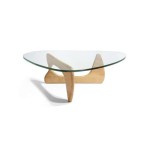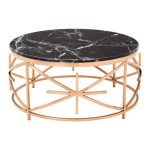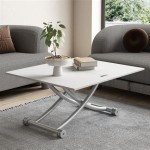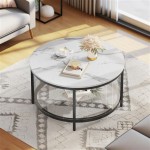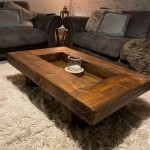Glass and Stone Coffee Tables: A Study in Modern Design and Functionality
The coffee table serves as a functional and aesthetic anchor within a living space. Beyond its practical purpose of holding beverages and other items, it contributes significantly to the overall design scheme. Glass and stone coffee tables represent a sophisticated option, blending contemporary design principles with durability and visual appeal. This article explores the attributes of glass and stone coffee tables, focusing on their design features, material characteristics, and considerations for integration into various interior styles.
The Allure of Glass in Coffee Table Design
Glass, as a material for coffee table tops, offers several distinct advantages. Its transparency creates an illusion of spaciousness, making it particularly suitable for smaller living rooms where maximizing visual openness is paramount. The reflective quality of glass also enhances ambient light, brighting the room and contributing to a more airy atmosphere. Furthermore, glass complements a wide variety of design styles, from minimalist and modern to transitional and even some contemporary iterations of traditional decor. A glass top allows the base of the table, whether it is crafted from wood, metal, stone, or a combination of materials, to be the focal point, showcasing intricate designs or contrasting textures.
Different types of glass are used in coffee table construction, each offering varying levels of durability and aesthetic qualities. Tempered glass, also known as safety glass, is the most common choice due to its resistance to breakage. When tempered glass does break, it shatters into small, relatively harmless pieces, minimizing the risk of injury. This makes it a safer option, especially in households with children or pets. Another option is laminated glass, which consists of two or more layers of glass bonded together with a plastic interlayer. Laminated glass is extremely strong and, even if broken, the interlayer prevents the glass fragments from scattering, further enhancing safety.
The thickness of the glass top is another crucial consideration. Thicker glass provides greater stability and load-bearing capacity, making it suitable for heavier objects. A thicker glass top also contributes to a more substantial and luxurious feel. The edges of the glass are typically finished with a bevel, polish, or rounded edge to prevent chipping and ensure safety. These edge treatments also add a touch of refinement to the overall design.
From a design perspective, glass can be clear, frosted, tinted, or even textured to create different visual effects. Clear glass offers a clean and minimalist look, while frosted glass provides a degree of privacy and conceals any imperfections beneath the tabletop. Tinted glass can add a subtle touch of color and warmth to the room, while textured glass introduces depth and visual interest. These customization options allow for the selection of a glass top that perfectly complements the surrounding decor.
Maintaining a glass coffee table requires regular cleaning to remove fingerprints, dust, and spills. A simple solution of water and vinegar or a commercially available glass cleaner is usually sufficient. It is essential to avoid using abrasive cleaners or scouring pads, as these can scratch the glass surface. Using coasters and placemats is also recommended to protect the glass from scratches and heat damage.
The Enduring Appeal of Stone in Coffee Table Design
Stone, as a material for coffee table tops or bases, embodies durability, elegance, and a connection to nature. Its inherent variations in color, pattern, and texture create a unique and organic feel, making each stone coffee table a one-of-a-kind piece. Stone coffee tables exude a sense of permanence and solidity, adding a touch of sophistication to any living space. Stone is a versatile material that complements a wide range of interior styles, from rustic and contemporary to minimalist and industrial. Its natural beauty and timeless appeal make it a popular choice for those seeking a statement piece that will stand the test of time.
Several types of stone are commonly used in coffee table construction, each with its own distinct characteristics. Marble, known for its luxurious veining and polished surface, is a classic choice that adds a touch of opulence to any room. Granite, with its speckled appearance and exceptional durability, is a practical option for high-traffic areas. Slate, with its earthy tones and textured surface, offers a more rustic and natural aesthetic. Limestone, with its subtle variations in color and smooth finish, provides a versatile option that blends well with various design styles. Travertine, with its characteristic pits and holes, adds a touch of texture and visual interest. The choice of stone will depend on the desired aesthetic, the level of durability required, and the overall design theme of the space.
The finish of the stone also plays a significant role in its appearance and performance. Polished stone, with its glossy and reflective surface, enhances the natural beauty of the stone and creates a sense of luxury. Honed stone, with its matte and smooth finish, offers a more understated and contemporary look. Textured stone, with its rough and uneven surface, adds a touch of tactility and visual interest. The choice of finish will depend on the desired aesthetic and the level of maintenance required. Polished stone is more prone to scratches and stains, while honed and textured stone are more forgiving.
The weight of stone is a significant consideration when choosing a stone coffee table. Stone is a heavy material, and the weight of the table will depend on the size and thickness of the stone top or base. It is essential to ensure that the floor can support the weight of the table and that it is easy to move and position. Some stone coffee tables have a lighter core material with a stone veneer to reduce the overall weight. These alternatives offer the aesthetic appeal of stone without the added weight and cost.
Maintaining a stone coffee table requires regular cleaning to remove dust, spills, and stains. The cleaning method will depend on the type of stone and the finish. For most types of stone, a mild soap and water solution is sufficient. It is essential to avoid using abrasive cleaners or acidic substances, as these can damage the stone surface. Sealing the stone is also recommended to protect it from stains and moisture damage. The frequency of sealing will depend on the type of stone and the level of usage. Stone is porous and can absorb liquids, leading to discoloration and staining if not properly sealed.
Integrating Glass and Stone: Design Synergies
The combination of glass and stone in a coffee table design presents an opportunity to create a visually striking and texturally rich piece of furniture. A popular design approach involves using a stone base topped with a glass surface. This allows the natural beauty of the stone to be showcased while providing a smooth and functional surface for everyday use. The transparency of the glass also allows the intricate details and patterns of the stone to be fully appreciated.
Alternatively, a glass base can support a stone top, creating a floating effect that emphasizes the weight and solidity of the stone. This design is particularly effective with minimalist interiors, where the clean lines and contrasting materials create a sense of visual balance. The glass base can be clear or tinted to further enhance the design aesthetic. The choice of glass and stone combinations allows for a wide range of design possibilities, catering to diverse tastes and preferences.
The juxtaposition of glass and stone creates a dynamic interplay of textures and colors. The smooth and reflective surface of the glass contrasts with the rough and organic texture of the stone, adding visual interest and depth to the design. The choice of colors can further enhance this contrast, with light-colored stone pairing well with clear glass and dark-colored stone complementing tinted or frosted glass. The combination of glass and stone can also create a sense of balance and harmony, blending the natural and the manufactured in a seamless and elegant manner.
The choice of materials and finishes should be carefully considered to ensure that the glass and stone complement each other. For example, a polished marble top might pair well with a clear glass base, while a honed slate top might be better suited to a frosted glass base. The overall design should also consider the scale and proportions of the table, ensuring that it is appropriately sized for the living space and that the glass and stone elements are visually balanced. The goal is to create a cohesive and harmonious design that enhances the overall aesthetic of the room.
When selecting a glass and stone coffee table, it is essential to consider the overall style of the room and the desired aesthetic. A glass and stone coffee table can serve as a focal point, adding a touch of elegance and sophistication to the space. It can also blend seamlessly with the existing decor, complementing the color palette, textures, and furniture styles. The key is to choose a design that reflects personal taste and enhances the overall ambience of the room. A well-chosen glass and stone coffee table can be a valuable addition to any living space, providing both functionality and aesthetic appeal.

The 19 Best Glass Coffee Tables To Now

Vintage Tesated Table Post Modern Stone Coffee Corner Postmodern 1980s Design

Table With Base In Stone And Top Glass Idfdesign

Glass Top Retro Travertine Coffee Table From Tigmi Trading Tables Stone

Post Modern Tesated Stone Coffee Table 1980s For At Pamono

Stone Coffee Table Tables Top Furniture

The 19 Best Glass Coffee Tables To Now

Coffee Table With Square Top In Glass Stone Base Idfdesign

Ivory Fossil Stone Sculptural Coffee Table With Biomorphic Glass Top Circa 1980

Stone Coffee Table Tables
